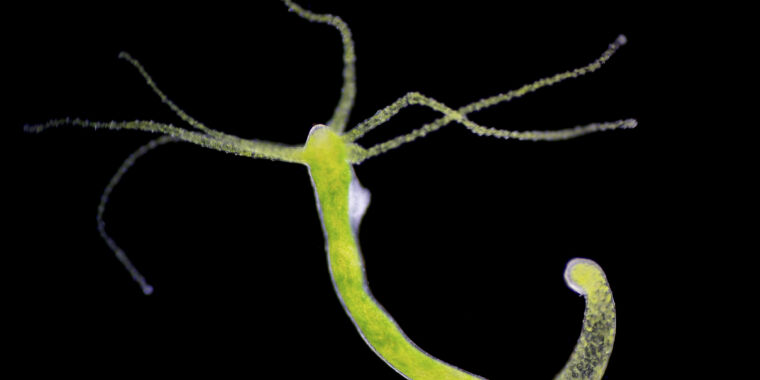How do brainless creatures control their appetites?

Feed me! —
Separate systems register when the animals have eaten and control feeding behaviors.

The hydra is a Lovecraftian-looking microorganism with a mouth surrounded by tentacles on one end, an elongated body, and a foot on the other end. It has no brain or centralized nervous system. Despite the lack of either of those things, it can still feel hunger and fullness. How can these creatures know when they are hungry and realize when they have had enough?
While they lack brains, hydra do have a nervous system. Researchers from Kiel University in Germany found they have an endodermal (in the digestive tract) and ectodermal (in the outermost layer of the animal) neuronal population, both of which help them react to food stimuli. Ectodermal neurons control physiological functions such as moving toward food, while endodermal neurons are associated with feeding behavior such as opening the mouth—which also vomits out anything indigestible.
Even such a limited nervous system is capable of some surprisingly complex functions. Hydras might even give us some insights into how appetite evolved and what the early evolutionary stages of a central nervous system were like.
No, thanks, I’m full
Before finding out how the hydra’s nervous system controls hunger, the researchers focused on what causes the strongest feeling of satiety, or fullness, in the animals. They were fed with the brine shrimp Artemia salina, which is among their usual prey, and exposed to the antioxidant glutathione. Previous studies have suggested that glutathione triggers feeding behavior in hydras, causing them to curl their tentacles toward their mouths as if they are swallowing prey.
Hydra fed with as much Artemia as they could eat were given glutathione afterward, while the other group was only given only glutathione and no actual food. Hunger was gauged by how fast and how often they opened their mouths.
It turned out that the first group, which had already glutted themselves on shrimp, showed hardly any response to glutathione eight hours after being fed. Their mouths barely opened—and slowly if so—because they were not hungry enough for even a feeding trigger like glutathione to make them feel they needed seconds.
It was only at 14 hours post-feeding that the hydra that had eaten shrimp opened their mouths wide enough and fast enough to indicate hunger. However, those that were not fed and only exposed to glutathione started showing signs of hunger only four hours after exposure. Mouth opening was not the only behavior provoked by hunger since starved animals also somersaulted through the water and moved toward light, behaviors associated with searching for food. Sated animals would stop somersaulting and cling to the wall of the tank they were in until they were hungry again.
Food on the “brain”
After observing the behavioral changes in the hydra, the research team looked into the neuronal activity behind those behaviors. They focused on two neuronal populations, the ectodermal population known as N3 and the endodermal population known as N4, both known to be involved in hunger and satiety. While these had been known to influence hydra feeding responses, how exactly they were involved was unknown until now.
Hydra have N3 neurons all over their bodies, especially in the foot. Signals from these neurons tell the animal that it has eaten enough and is experiencing satiety. The frequency of these signals decreased as the animals grew hungrier and displayed more behaviors associated with hunger. The frequency of N3 signals did not change in animals that were only exposed to glutathione and not fed, and these hydra behaved just like animals that had gone without food for an extended period of time. It was only when they were given actual food that the N3 signal frequency increased.
“The ectodermal neuronal population N3 is not only responding to satiety by increasing neuronal activity, but is also controlling behaviors that changed due to feeding,” the researchers said in their study, which was recently published in Cell Reports.
Though N4 neurons were only seen to communicate indirectly with the N3 population in the presence of food, they were found to influence eating behavior by regulating how wide the hydras opened their mouths and how long they kept them open. Lower frequency of N4 signals was seen in hydra that were starved or only exposed to glutathione. Higher frequency of N4 signals were associated with the animals keeping their mouths shut.
So, what can the neuronal activity of a tiny, brainless creature possibly tell us about the evolution of our own complex brains?
The researchers think the hydra’s simple nervous system may parallel the much more complex central and enteric (in the gut) nervous systems that we have. While N3 and N4 operate independently, there is still some interaction between them. The team also suggests that the way N4 regulates the hydra’s eating behavior is similar to the way the digestive tracts of mammals are regulated.
“A similar architecture of neuronal circuits controlling appetite/satiety can be also found in mice where enteric neurons, together with the central nervous system, control mouth opening,” they said in the same study.
Maybe, in a way, we really do think with our gut.
Cell Reports, 2024. DOI: 10.1016/j.celrep.2024.114210



